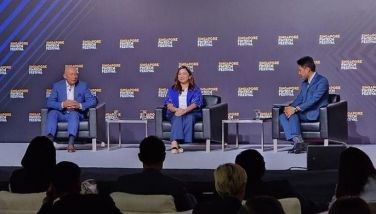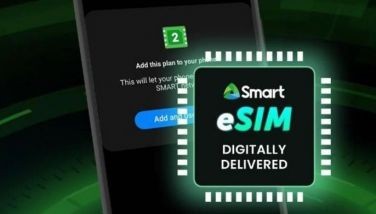Youths take charge of environment through Smart's Project Rain Gauge
MANILA, Philippines - In her desire to be more environmentally aware and responsible, science teacher Marinella Garcia-Sy became interested in rainfall monitoring for the purpose of gathering data. She got involved in Project Rain Gauge, and eventually recruited her co-teachers and students at the San Miguel National High School, one of the first schools to support the project.
Project Rain Gauge is an initiative of Smart Communications Inc. under its Smart Schools Program (SSP). Its goal is to create a network of ground stations across the country that would provide supplementary data on local rainfall measurement in specific areas.
Project partners include the Philippine Atmospheric, Geophysical and Astronomical Services Administration (Pagasa), KLIMA Climate Change Center, the Manila Observatory, and the Department of Education.
To date, there are 50 Smart Schools participating in the effort to monitor rainfall in their respective communities with the use of rain gauges installed by Smart on their campuses.
“With the help of my students, I have been implementing Project Rain Gauge since I underwent training on rainfall monitoring during a workshop hosted by Smart,“ says Garcia-Sy, a secondary science teacher 1.
She divided her students into groups of seven with a different group assigned every week. Every day a different member monitors rainfall using a manual rain gauge. The group leader submits the journal with the week’s rainfall reading.
After verifying the entries, another student then uploads the rainfall data to the Project Rain Gauge website. At the end of the school year, the groups are required to submit a consolidated report of all their recorded rain gauge readings.
The previous two batches of fourth-year Section 1 students took part in the exercise. But for this school year, Garcia-Sy assigned sophomores from the science class to do the rainfall observation and data recording, this time from both the manual rain gauge and the digital rain gauge donated by Smart and recently installed in their school.
“I realized that it doesn’t matter what year level you assign. As long as you instill environmental concern and awareness among the students, they will want to get involved,” says Garcia-Sy.
Sophomore Lyrra Magtalas considers it a privilege to take part in the rainfall monitoring, saying “the records are treasures.”
Classmate Imee Macaranas is thrilled that they get to compare their rainfall reading with Pagasa’s weather forecast. “They record the day’s overall weather condition gathered from different sources such as the television, radio, Internet, and newspaper in their journal alongside the rainfall data obtained from the rain gauges. This way, they can observe the local and national weather conditions as reported from different sources,” explains Garcia-Sy.
She also asks her students to make a diary during weekends on how they are implementing the Low-Carbon Diet, an environmental awareness initiative of the Ateneo De Manila University that Garcia-Sy learned about during a Project Rain Gauge workshop. It focuses on recycling, energy conservation and responsible use of resources.
“Little by little, the school community realizes the importance of observing and monitoring the weather as an important indicator of how things are going to be for the next 24 hours. At a young age, students are learning how to be conscious and responsible for their surroundings, realizing man’s role as a caretaker of his domain,” she notes.
The school’s semi-annual paper, The Mayumo, has been featuring Project Rain Gauge, making the undertaking known to the school’s 6,000 students and 200 teachers.
“The school’s Science Club also participates in the project by collaborating with us like during Project Rain Gauge’s 3rd Convention,” Garcia-Sy says.
The two-day convention gathered representatives of Smart Schools participating in the project. Science teachers from schools nationwide visited San Miguel NHS, selected as pilot school in the use of a digital rain gauge to complement the existing manual rain gauge.
Guest speaker Vicente Manalo III, weather specialist at the Farm Weather Services Section of Pagasa, gave a lecture and demonstration on the proper installation, use and maintenance of the digital rain gauge.
The deployment of digital rain gauges is among the recent developments in the project, aside from an SMS-based reporting system made possible via a mobile application developed by the Ateneo Java Wireless Competency Center.
Also unveiled during the convention was the new project website — www.projectraingauge.ph. Developed and managed by Smart, it includes a rainfall data page where the school reports submitted via SMS or online are automatically consolidated in charts and graphs.
Garcia-Sy and other “rain gaugers” are excited over these improvements. “The SMS-based reporting will prove to be convenient, especially when there is no Internet access. The new website, I find more personalized and tailor-made for the Project Rain Gauge community,” she says.
Together with the latest enhancements is an effort to integrate Project Rain Gauge in the science curriculum. During the convention, Dr. Susan Espinueva, assistant weather services chief of the Hydro Metrological Division of Pagasa, conducted a workshop for the teachers to guide them on how to develop a lesson plan based on rainfall-related topics.
In line with the project’s long-term goal, Garcia-Sy hopes to correlate the rainfall data collected by their school with the flooding data of San Miguel River. She also looks forward to a possible consortium with the local government through the National Disaster Coordinating Council.
“The potential of Project Rain Gauge is great and we are definitely taking it to a higher level. We started it out as an exercise in science learning. In the future it can become a vital source of information that may be utilized by science agencies like Pagasa as a potential community-based early warning system,” says Darwin Flores, Smart Public Affairs Community Partnerships senior manager.
This piece of news impassions Garcia-Sy all the more.
“San Miguel, the northernmost town of Bulacan, is a calamity-prone area. We have local residents and school children wading in muddy waters during the rainy season. This perennial problem can be best remedied through a preventive measure. Our school, through Project Rain Gauge, would only be too willing to contribute to the improvement of disaster preparedness in our locality,” she says.
- Latest

























